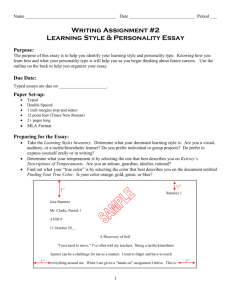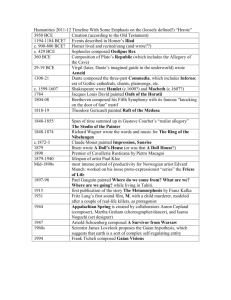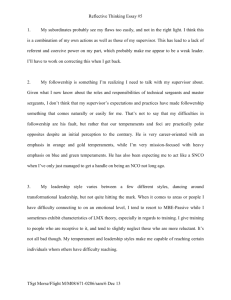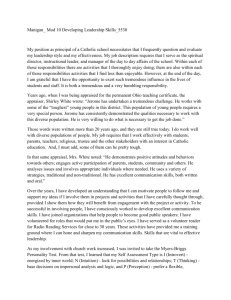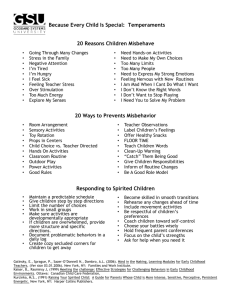The Four Keirsey Temperaments
advertisement
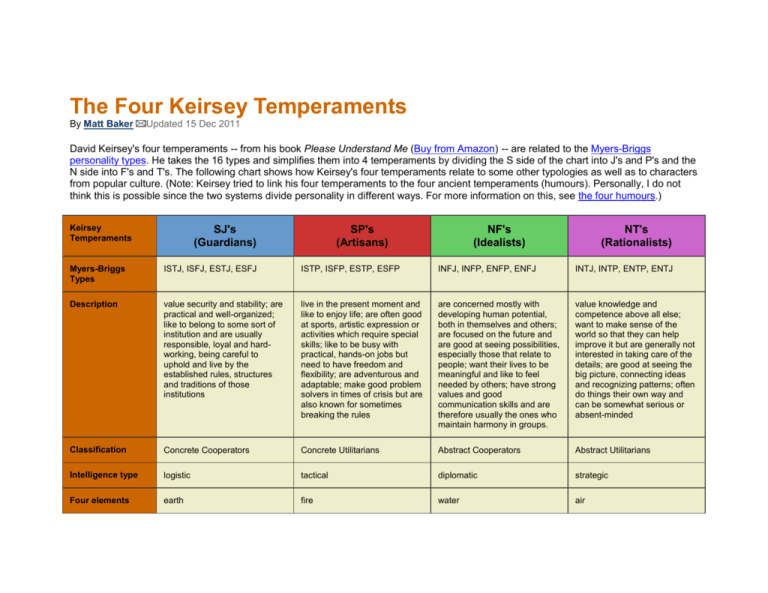
The Four Keirsey Temperaments By Matt Baker Updated 15 Dec 2011 David Keirsey's four temperaments -- from his book Please Understand Me (Buy from Amazon) -- are related to the Myers-Briggs personality types. He takes the 16 types and simplifies them into 4 temperaments by dividing the S side of the chart into J's and P's and the N side into F's and T's. The following chart shows how Keirsey's four temperaments relate to some other typologies as well as to characters from popular culture. (Note: Keirsey tried to link his four temperaments to the four ancient temperaments (humours). Personally, I do not think this is possible since the two systems divide personality in different ways. For more information on this, see the four humours.) Keirsey Temperaments SJ's (Guardians) SP's (Artisans) NF's (Idealists) NT's (Rationalists) Myers-Briggs Types ISTJ, ISFJ, ESTJ, ESFJ ISTP, ISFP, ESTP, ESFP INFJ, INFP, ENFP, ENFJ INTJ, INTP, ENTP, ENTJ Description value security and stability; are practical and well-organized; like to belong to some sort of institution and are usually responsible, loyal and hardworking, being careful to uphold and live by the established rules, structures and traditions of those institutions live in the present moment and like to enjoy life; are often good at sports, artistic expression or activities which require special skills; like to be busy with practical, hands-on jobs but need to have freedom and flexibility; are adventurous and adaptable; make good problem solvers in times of crisis but are also known for sometimes breaking the rules are concerned mostly with developing human potential, both in themselves and others; are focused on the future and are good at seeing possibilities, especially those that relate to people; want their lives to be meaningful and like to feel needed by others; have strong values and good communication skills and are therefore usually the ones who maintain harmony in groups. value knowledge and competence above all else; want to make sense of the world so that they can help improve it but are generally not interested in taking care of the details; are good at seeing the big picture, connecting ideas and recognizing patterns; often do things their own way and can be somewhat serious or absent-minded Classification Concrete Cooperators Concrete Utilitarians Abstract Cooperators Abstract Utilitarians Intelligence type logistic tactical diplomatic strategic Four elements earth fire water air (typology.net) (stabilizer) (activator) (unifier) (clarifier) Sources of happiness (Aristotle) material sensual ethical logical Card suits / medieval roles diamonds (merchants) clubs (workers) hearts (priests) spades (soldiers/rulers) Four living creatures (Ez. 1:10; Rev. 4:7) ox (hard working) lion (courageous) human (compassionate) eagle (sees the big picture) Four Gospels Matthew (an orderly account written by a tax collector) Mark (a fast-paced, action-oriented account) Luke (a people-centered account written by a physician) John (a more symbolic, theologized account) Hindu paths to salvation bhakti yoga (salvation via devotion) karma yoga (salvation via action) raja yoga (salvation via meditation) jnana yoga (salvation via knowledge) Wizard of Oz Dorothy (wanted to go home) The lion (wanted courage) The tin man (wanted a heart) The scarecrow (wanted a brain) Harry Potter Hufflepuff (hardworking) Gryffindor (courageous) Slytherin (idealistic) Ravenclaw (brainy) Narnia Susan (practical) Edmund (impulsive) Lucy (caring) Peter (leaderly)
